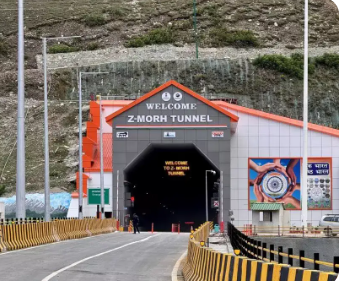1. Introduction: A New Era for Connectivity in the Kashmir-Ladakh Region
PM to Open Z-Morh Tunnel, a significant boost to India’s infrastructure and defense connectivity, Prime Minister Narendra Modi is all set to inaugurate the Z-Morh tunnel, a major project that will ensure year-round access between Kashmir and Ladakh. This development is part of a larger strategic plan to connect the region more effectively, facilitating easier movement of people, goods, and services. Hoteliers and local businesses are particularly excited, as the tunnel promises to revolutionize tourism in the Sonamarg area by providing safe access during the harsh winter months.
As part of this ambitious project, the Z-Morh tunnel complements another mega-structure that is under construction: the Zojila Tunnel, which will be the longest road tunnel in Asia upon its completion. Together, these two tunnels aim to transform the connectivity of the entire Kashmir-Ladakh corridor and provide long-term benefits for both defense logistics and civilian travel.
This article delves deeper into the significance of the PM to Open Z-Morh Tunnel, its impact on tourism, its role in national security, and the wider implications for regional development.  For the more information click on this link
For the more information click on this link
2. Understanding the Z-Morh Tunnel Project
2.1 What is the Z-Morh Tunnel?
The PM to Open Z-Morh Tunnel, is an engineering marvel, designed to improve the transport infrastructure in the difficult terrain of Jammu and Kashmir. Located near Sonamarg, a popular tourist destination in the Ganderbal district of Jammu and Kashmir, the tunnel will provide a direct road link for vehicles, ensuring uninterrupted access during the winter months when the region is frequently cut off due to heavy snowfall. This strategic tunnel is expected to significantly enhance transportation between the Kashmir valley and Ladakh.
Constructed at an altitude of 2,730 meters, the tunnel spans a length of approximately 6.5 kilometers and will alleviate the longstanding challenge of seasonal road closures in the region. The opening of this tunnel will shorten the travel time considerably and make routes safer for commuters traversing this treacherous terrain.
2.2 Features and Specifications of the Z-Morh Tunnel
The Z-Morh tunnel, once opened, will provide multiple benefits, PM to Open Z-Morh Tunnel, not just for road connectivity but also for safety and efficiency. Among its key features:
- All-Weather Connectivity: This is the first all-weather tunnel in the region, capable of allowing safe travel even during the harshest winters.
- Double Tube Design: It is a twin-tube tunnel, ensuring easier access for vehicles moving in both directions, along with an emergency evacuation tube for additional safety.
- Modern Technology: The project features state-of-the-art technology, PM to Open Z-Morh Tunnel, including ventilation, lighting, and a robust traffic management system to ensure smooth operations.
- Enhanced Safety: The tunnel will be equipped with an advanced monitoring system, including automatic incident detection systems, making it one of the safest tunnels in the world.
This tunneling project is expected to ease traffic congestion on existing routes, reduce travel times, and minimize the risks typically associated with mountainous and weather-prone routes. Importantly, it will bring much-needed relief to locals, businesses, and tourists, particularly during the winter season, PM to Open Z-Morh Tunnel, when travel between Kashmir and Ladakh is difficult due to snow blockages.
3. The Importance of Z-Morh Tunnel for Tourism
3.1 Impact on Sonamarg’s Tourism Industry
One of the key benefits anticipated with the completion of the PM to Open Z-Morh Tunnel, is its transformative effect on the tourism sector in the Sonamarg region. Sonamarg, also known as the “Meadow of Gold,” has long been one of the most visited places by domestic and international tourists due to its breathtaking natural beauty. The newly constructed tunnel will ensure that tourists can easily visit Sonamarg all year round, even during the thick of winter.
Before the construction of the Z-Morh tunnel, tourist destinations like Sonamarg were only accessible during the warmer months. When snowstorms hit in winter, the existing routes would be completely cut off, severely affecting not just tourism but also the livelihood of businesses that rely on the tourism sector. Now, with the tunnel, travelers can continue to visit and enjoy the snow-capped landscape, frozen lakes, PM to Open Z-Morh Tunnel, and trekking experiences, even during the off-season, thereby giving Sonamarg a continuous inflow of tourists.
3.2 Winter Tourism and Increased Footfall
The long stretches of snowy landscapes in places like Sonamarg and Kargil are favorite attractions for winter tourists. In previous years, it would have been impossible for people to make it to these destinations during peak winter months, but with the tunnel, PM to Open Z-Morh Tunnel, these locations can continue to thrive even in the coldest seasons. The ease of access would, therefore, enhance the visitor experience and appeal to tourists from other parts of India and abroad, especially those keen to explore winter destinations.
4. The Strategic Importance for Defense Connectivity
4.1 Strengthening National Defense
While the economic and tourist-driven benefits of thePM to Open Z-Morh Tunnel, cannot be overstated, one of its most vital functions is improving the national defense infrastructure. Ladakh, a sensitive border area in India, shares borders with both China and Pakistan, and ensuring robust military logistics and communication is of the utmost importance. The Z-Morh tunnel is strategically located as part of a broader effort to create a permanent, secure road link between Kashmir and Ladakh, which can be crucial in times of conflict or national security threats.
The construction of this tunnel, along with the ongoing Zojila Tunnel project, will significantly reduce the time it takes for military convoys to move personnel, supplies, and ammunition along this route. This is especially critical for border security operations where timely response is often a decisive factor.
Furthermore, PM to Open Z-Morh Tunnel, these improved roads ensure that troops stationed in Ladakh can be swiftly reinforced with supplies or reinforcements as necessary, fostering a faster and more reliable response in the event of an emergency or attack.
4.2 Reducing Dependency on Air Travel
Currently, the Indian Army relies heavily on air transport to move logistics between Kashmir and Ladakh, which can be subject to weather disruptions and limited capacity. With the construction of the PM to Open Z-Morh Tunnel, and other infrastructure improvements, the reliance on air freight for essential supplies could be drastically reduced, further ensuring the security of these critical regions.
5. The Zojila Tunnel: Complementing Z-Morh Tunnel in Creating an Efficient Kashmir-Ladakh Corridor
5.1 What is the Zojila Tunnel?
Complementing thePM to Open Z-Morh Tunnel, is the ongoing construction of the Zojila tunnel. When completed, the Zojila Tunnel will be the longest road tunnel in Asia, stretching approximately 14.2 kilometers. Connecting the Kashmir valley to Ladakh, it will bypass the traditional mountain passes that are prone to snow blockages during winter.
While the Z-Morh tunnel primarily serves the Sonamarg-Ganderbal route, the Zojila tunnel will serve as the crucial passage for those traveling further into Ladakh. The twin-tube tunnel will not only provide an all-weather road link for the region but also further cement Ladakh’s connectivity with Kashmir, making it possible to travel throughout the year.
5.2 Combining Zojila and Z-Morh Tunnels
The development of both tunnels creates a powerful, integrated road system that links the two strategically significant regions of Kashmir and Ladakh. Both tunnels, PM to Open Z-Morh Tunnel, part of the larger National Highway 1-A, will reduce the reliance on road and air travel that was earlier dependent on favorable weather conditions. By joining the dots of this critical infrastructure, these tunnels make for one of the most significant improvements in India’s infrastructure, especially in its border areas.
6. Economic Implications of the Z-Morh Tunnel
6.1 Boosting Local Economy
The Z-Morh tunnel is expected to be a significant economic catalyst, PM to Open Z-Morh Tunnel, directly benefiting the local population by boosting trade, tourism, and daily transport. Local markets and businesses will benefit from a consistent flow of tourists and goods, while the region’s integration into the larger Indian economic system will offer new avenues for growth.  For the more information click on this link
For the more information click on this link
6.2 Enhancing Trade Connectivity
Access to better infrastructure will make it easier for goods and services to move between Kashmir and Ladakh, particularly agricultural produce, handicrafts, and local resources. This could stimulate trade between the two regions and to other parts of India, bringing tangible economic growth to both territories.
7. Conclusion: A Historic Milestone for India’s Strategic Infrastructure
The Z-Morh tunnel symbolizes a significant step forward in India’s efforts to improve its regional connectivity, especially in the Kashmir-Ladakh corridor. Combining military strategic advantages with the developmental objectives of improving tourism, the tunnel promises to enhance the security, accessibility, and prosperity of one of the most beautiful, yet challenging regions in India.
With the ongoing Zojila tunnel construction and the opening of the Z-Morh tunnel, India is moving towards an era of improved connectivity that not only ensures the safety of its borders but also unlocks economic potential for the region. For the people of Kashmir and Ladakh, this is an exciting time, PM to Open Z-Morh Tunnel, as they stand to benefit greatly from a more connected, prosperous future. The Z-Morh tunnel will play a pivotal role in shaping the destiny of the region, contributing to both national security and economic resilience for ALSO READ:-Nobel Laureate Malala Yousafzai to Visit Native Pakistan for Girls’ Education Summit: A Step Toward Empowering the Future 2025





